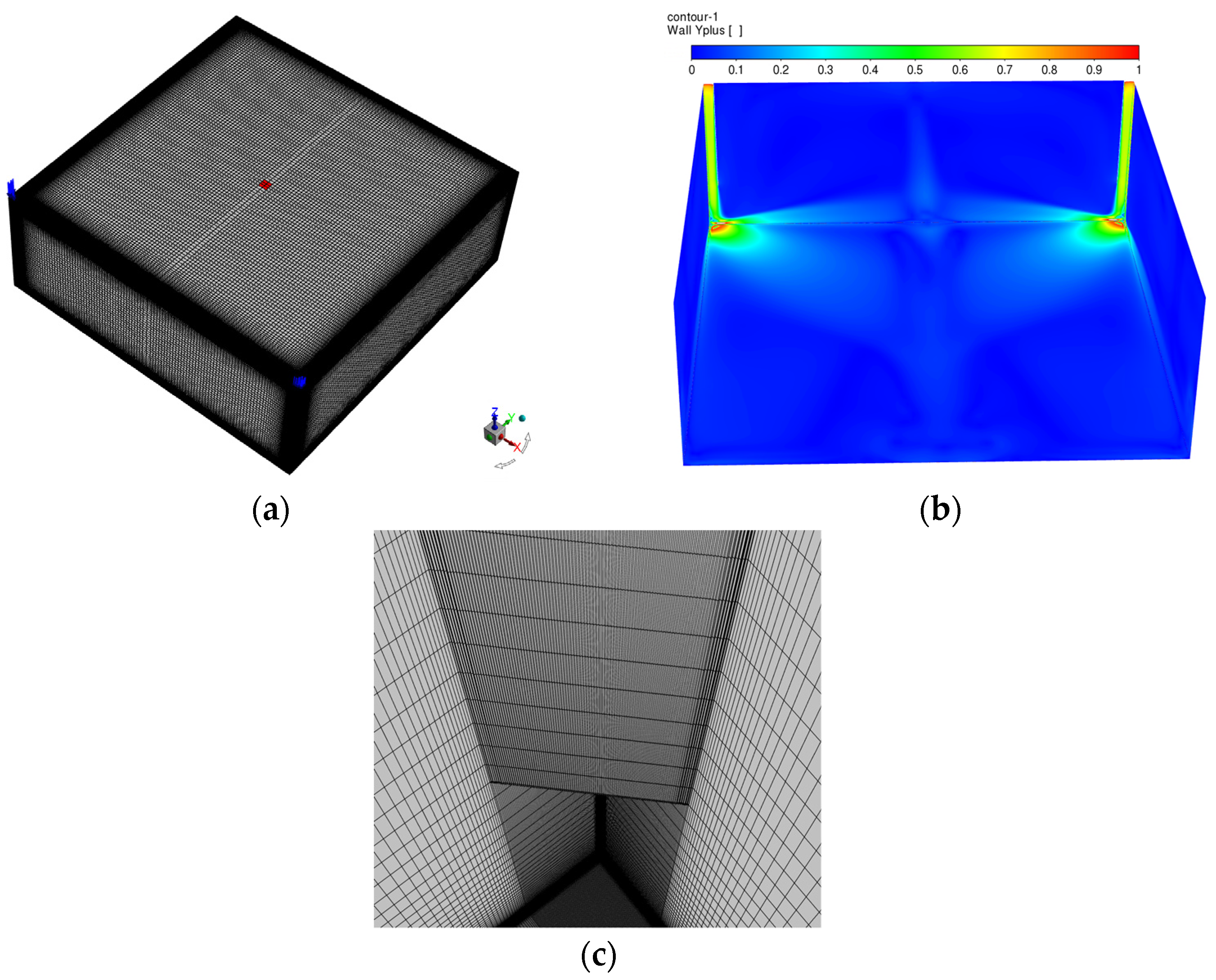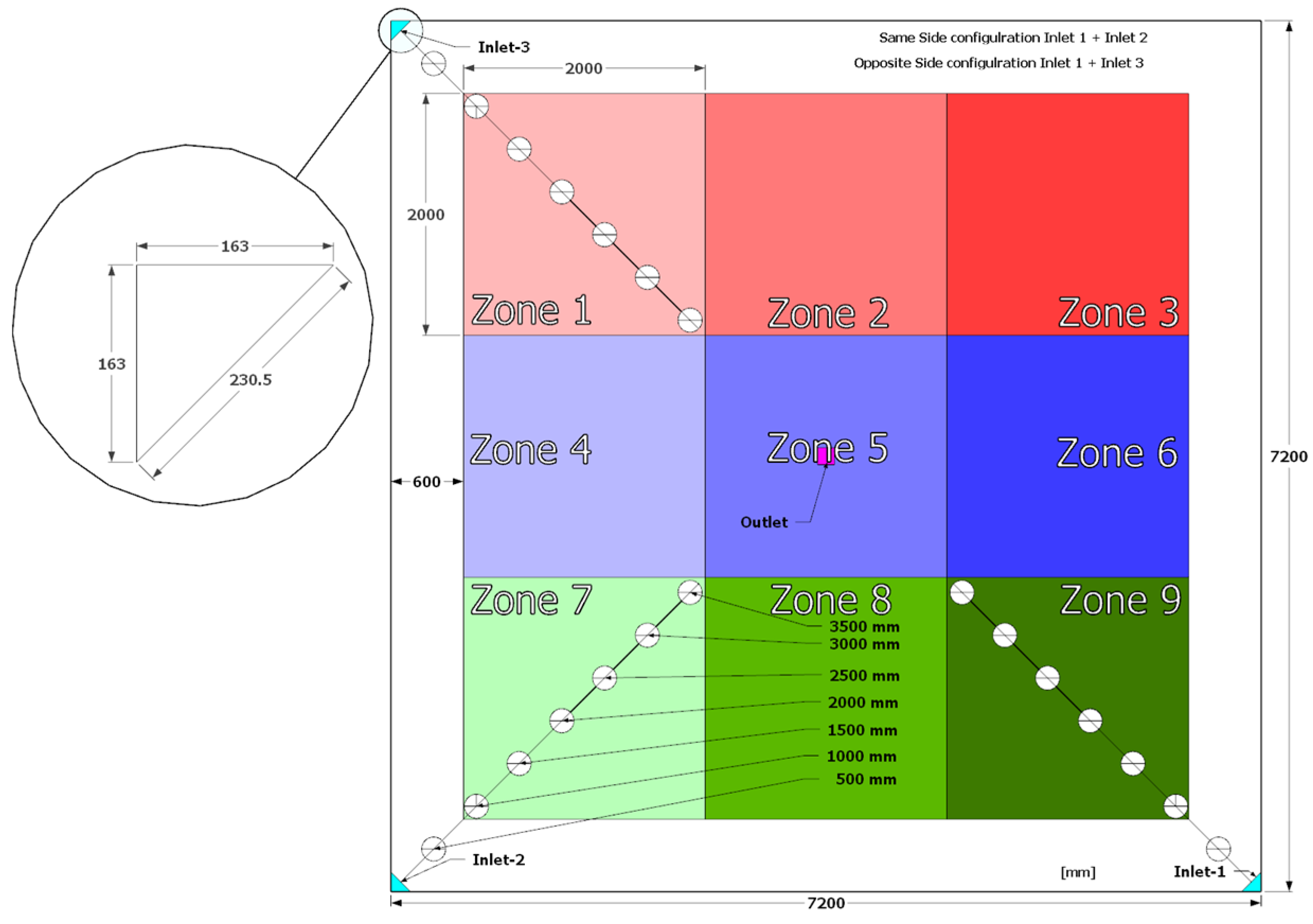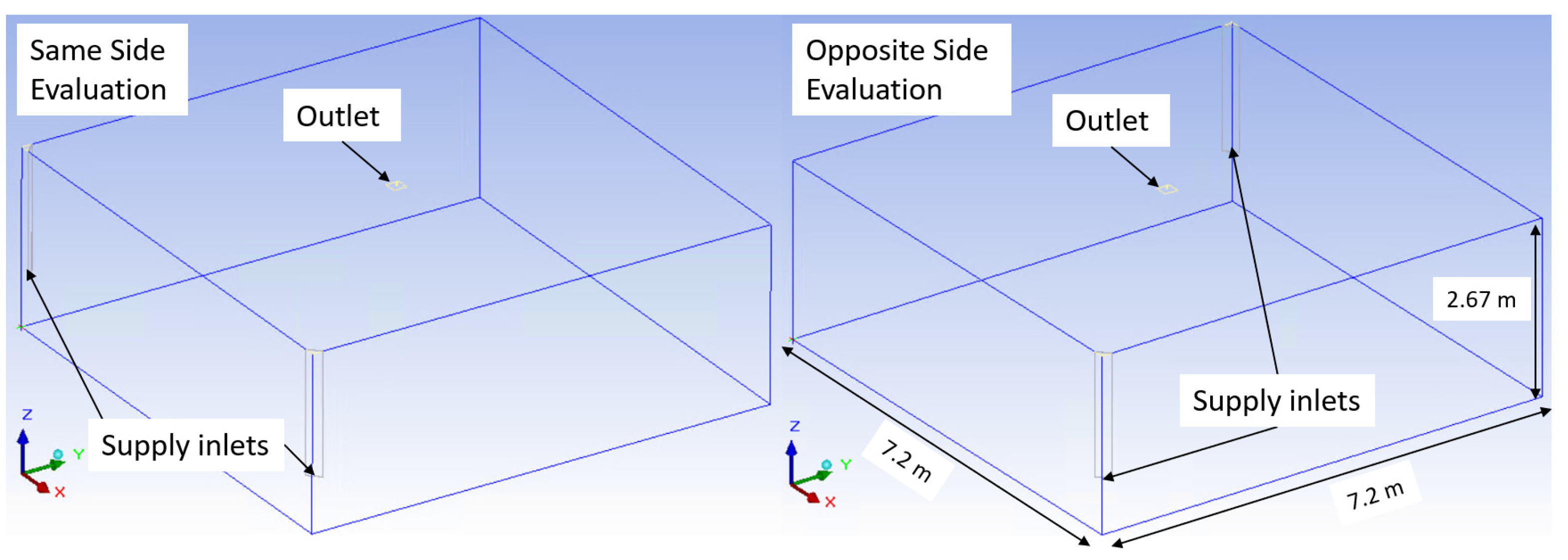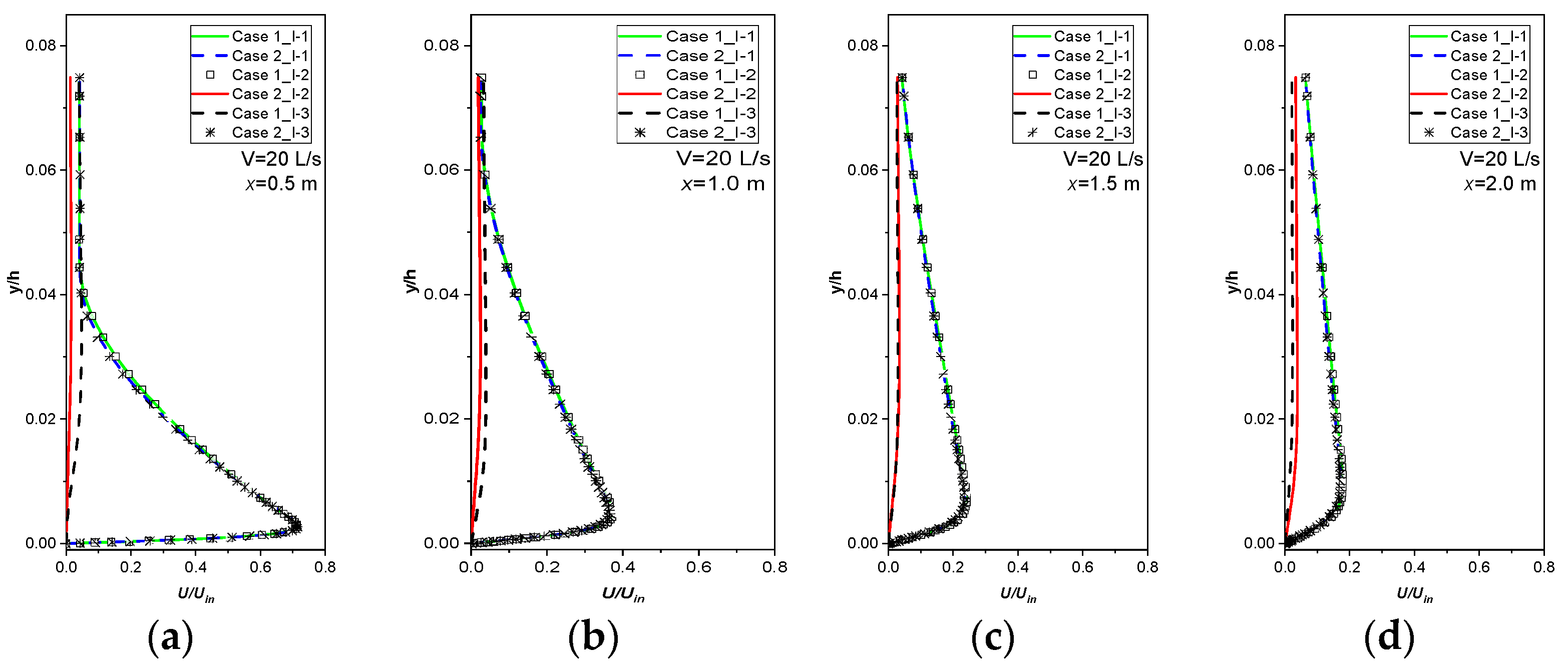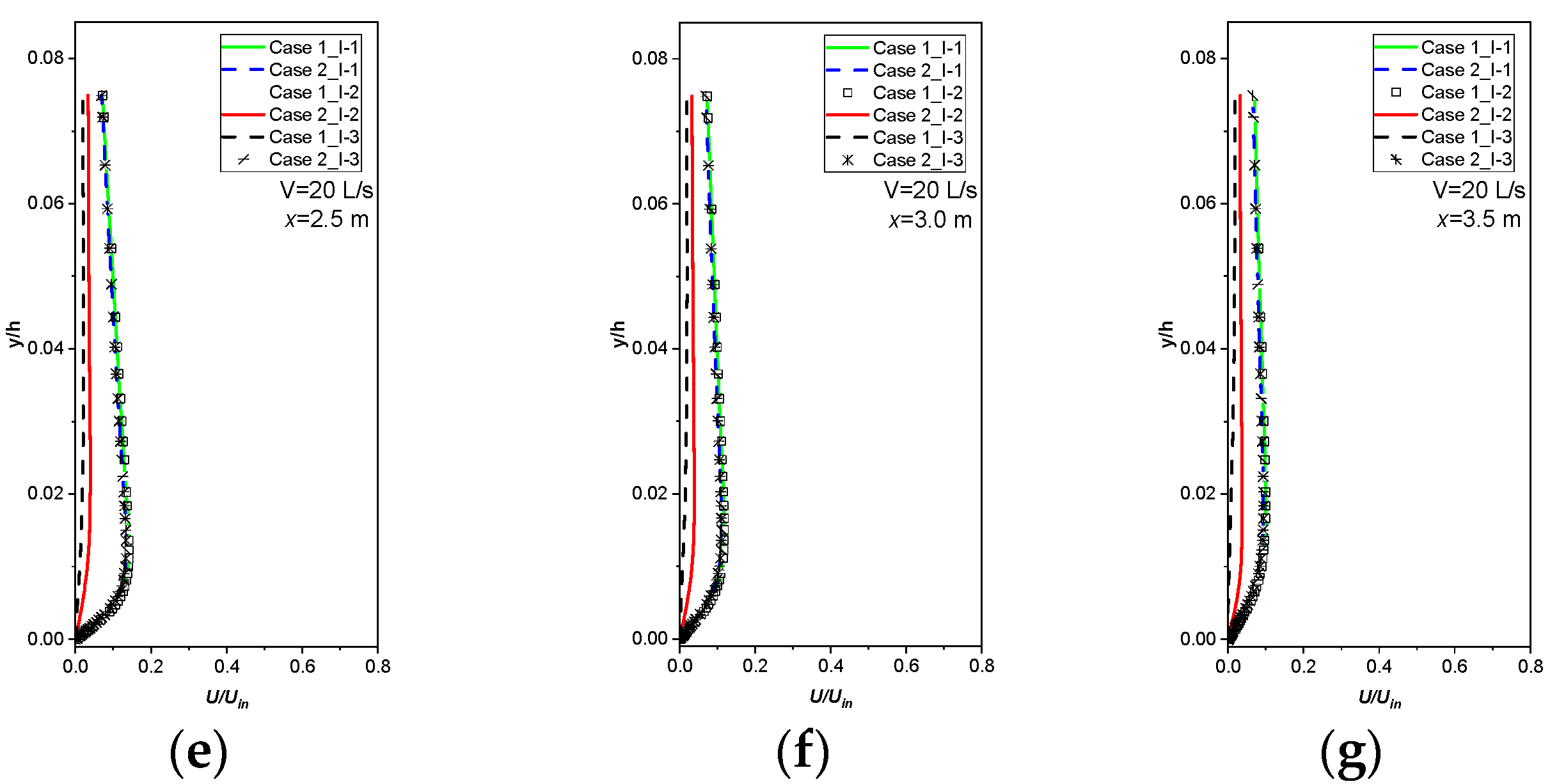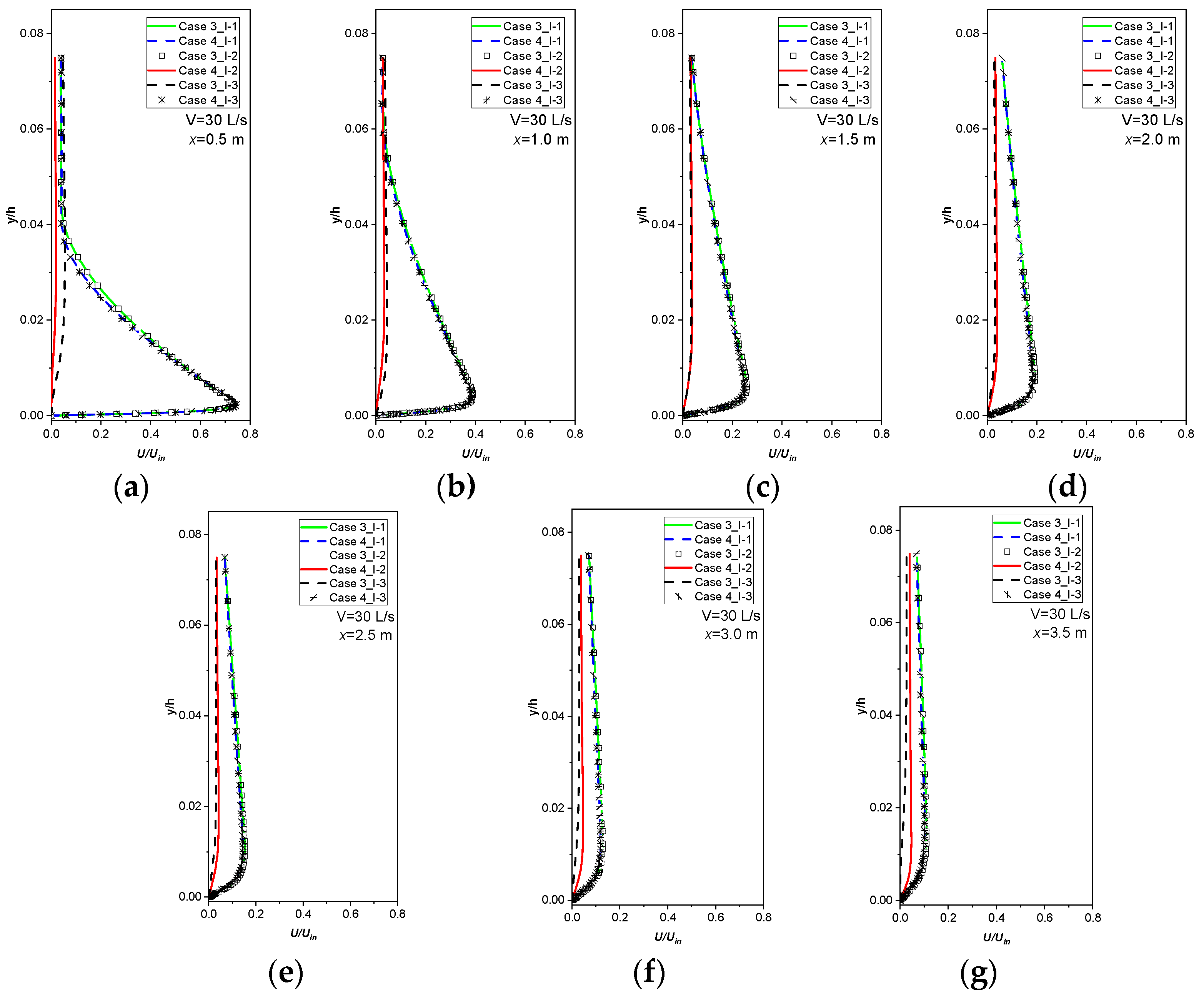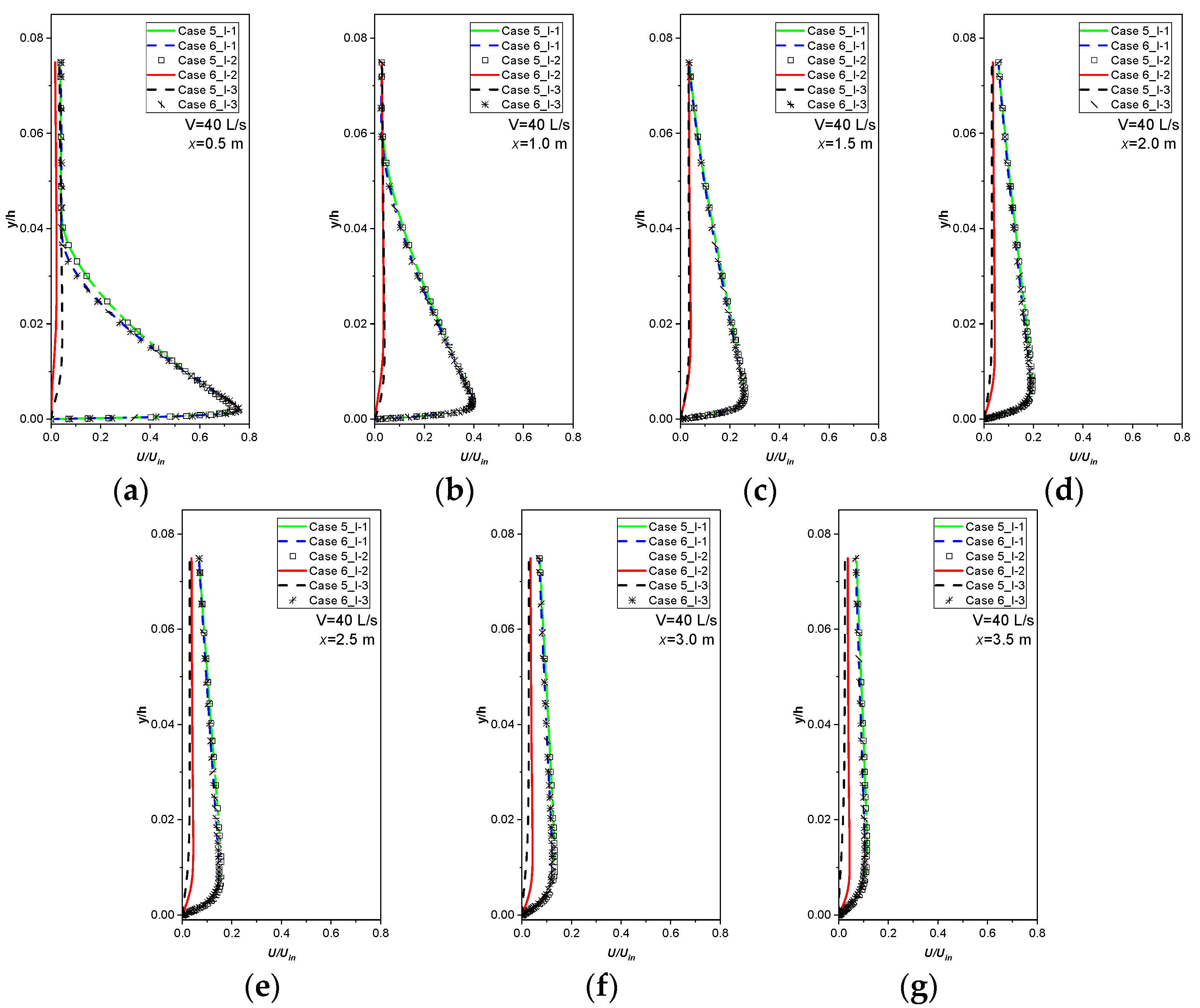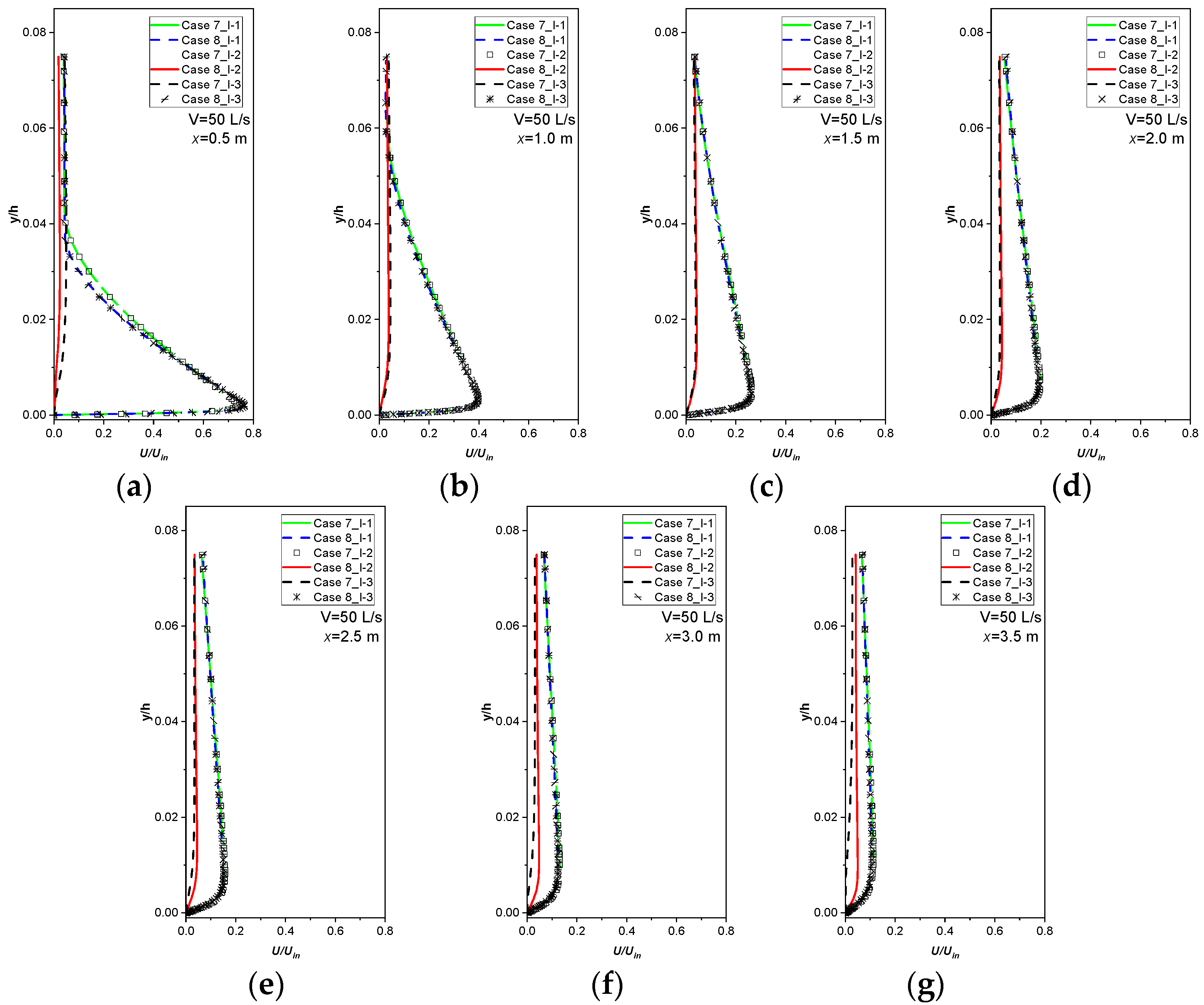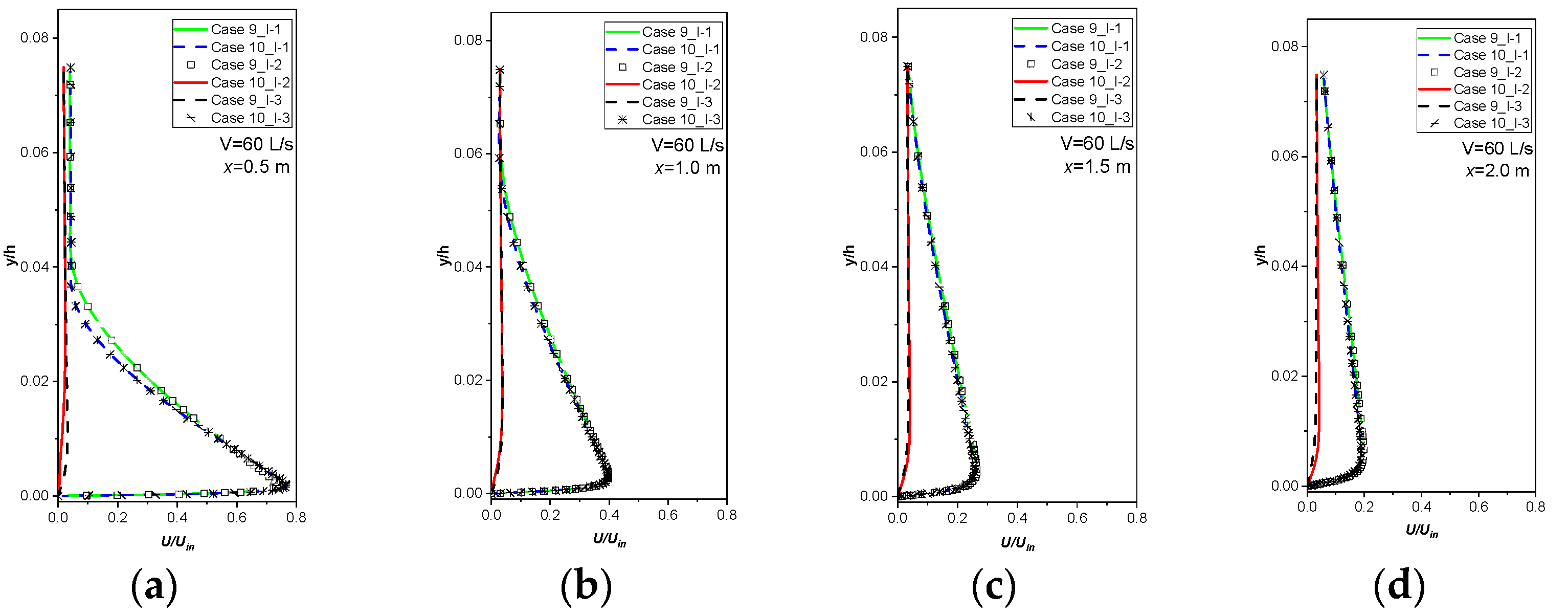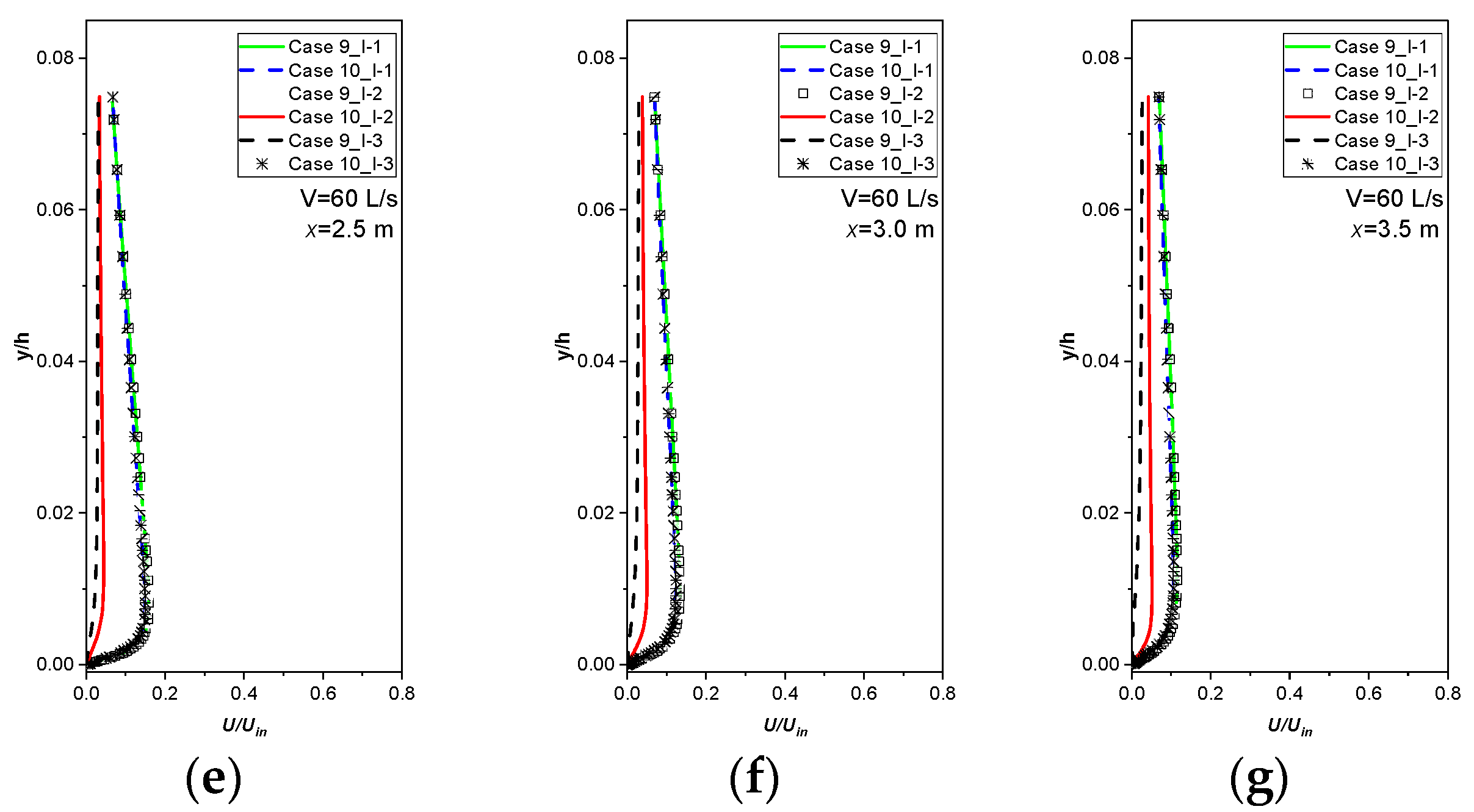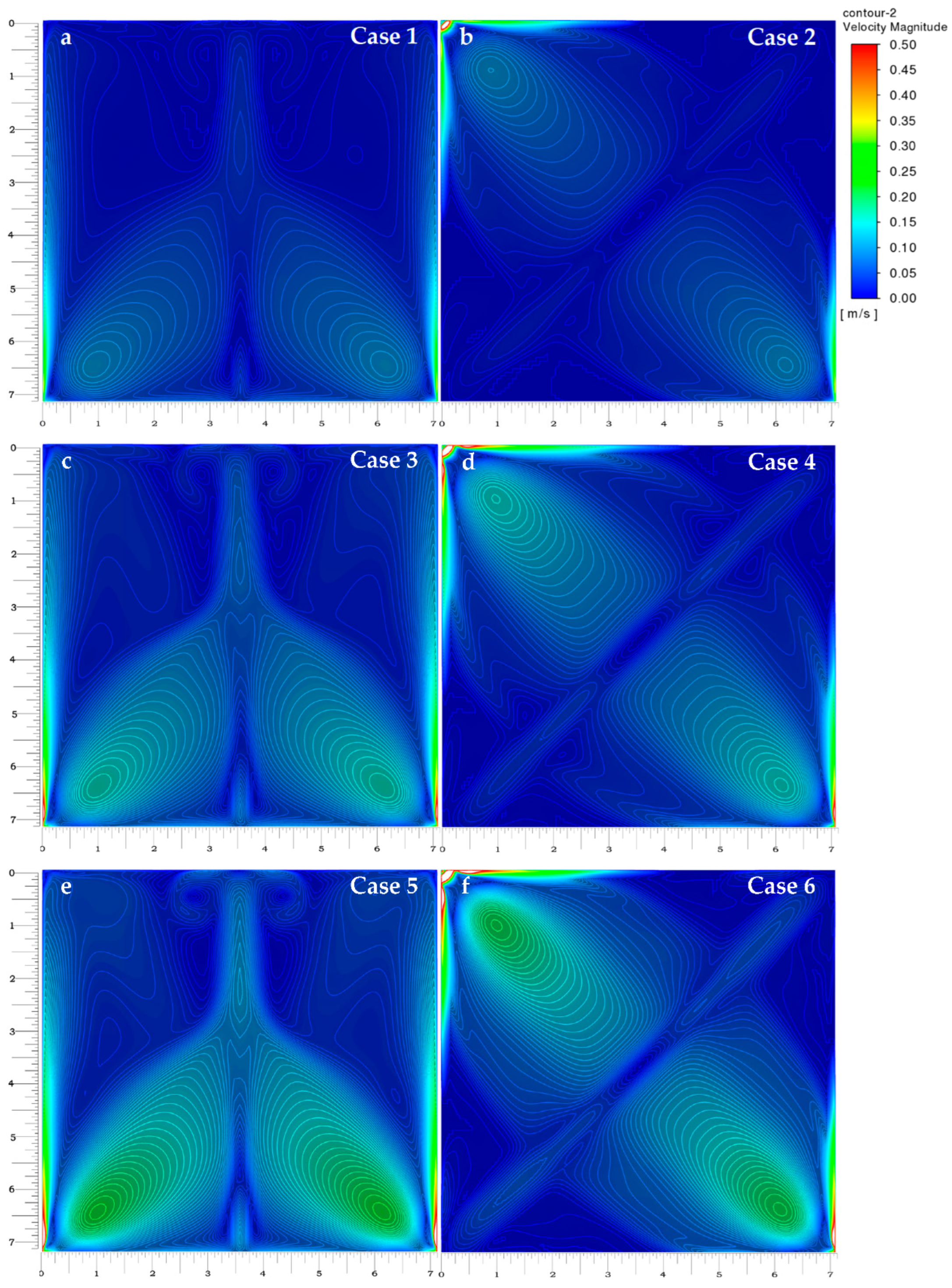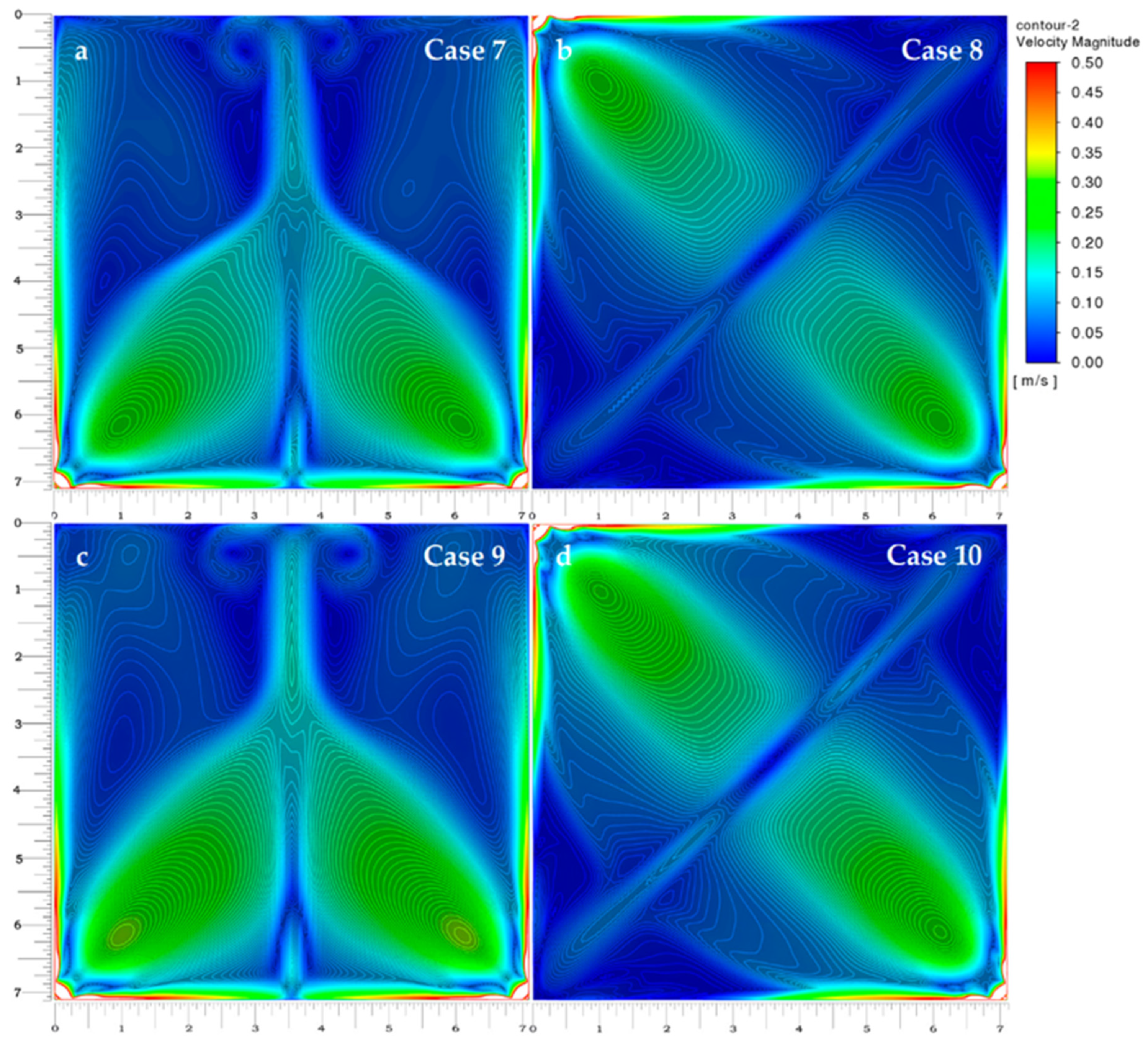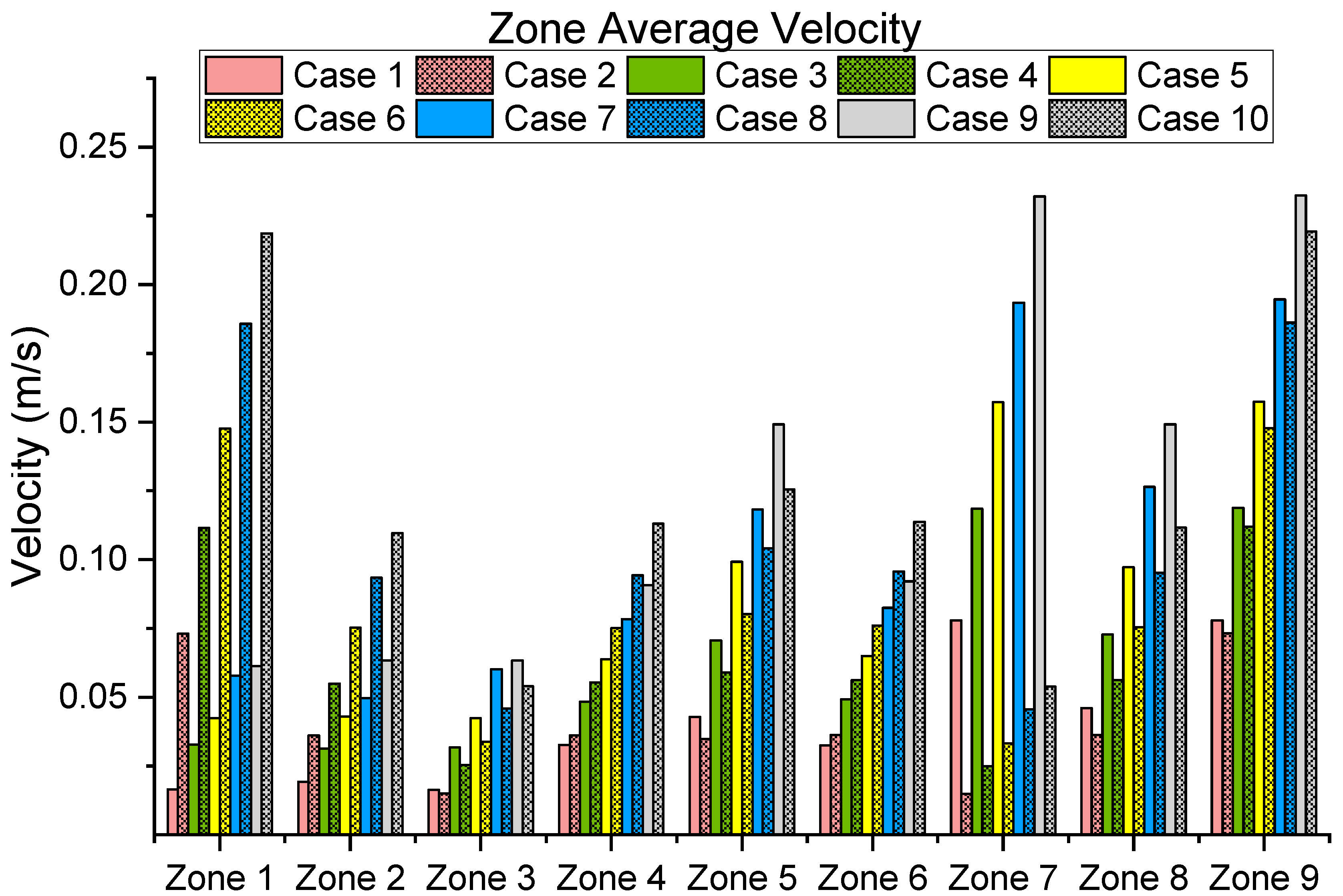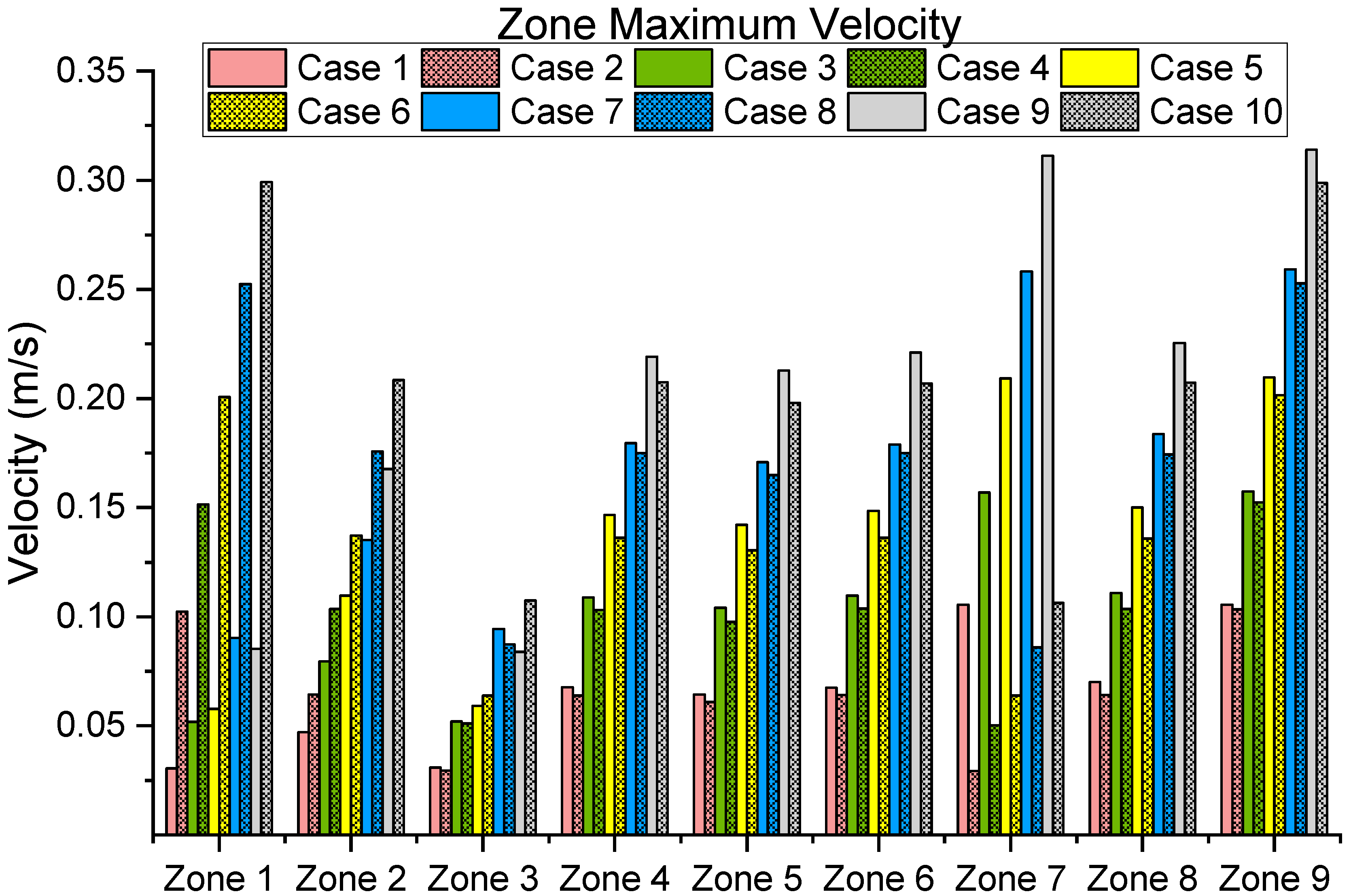3.1. Velocity Profile
Figure 4 shows the results of the air velocity development along the centerline at different distances from the corner when evaluating the cases at V = 20 L/s (10 L/s per inlet). The results are presented in dimensionless form, where
y/
h is the height from the floor divided by the room height (
h = 2.67 m) and
U/Uin is the velocity (
U) divided by the nominal inlet velocity (
Uin). When evaluating the cases at V = 20 L/s, it can be seen that, at
x = 0.5 m (
Figure 4a), when there is inlet close to the evaluation points, i.e., Case-1 I-1, Case-2 I-1, Case-1 I-2, and Case-2 I-3, the velocity profiles have a similar peak velocity; however, there is a small difference. The peak velocity is 0.53 m/s for Case-1 I-1, 0.54 m/s for Case-2 I-1, 0.53 m/s for Case-1 I-2, and 0.54 m/s for Case-2 I-3. The results also show that the jet at
x = 0.5 m is mainly contained below
y/
h = 0.04 for these cases. When comparing Case-1 vs. Case-2, the results show a slightly lower velocity for Case-1. When evaluating the diagonal centerline when there is no inlet in close proximity, the results show that the general velocity in these areas is much lower.
Moreover, when comparing Case-2 I-2 vs. Case-1 I-3, where there is no inlet close to the evaluation points, the results show a slightly higher velocity starting around y/h = 0.01 and upwards for Case-1 I-3 when m. This indicates that having the inlets on the same side increases the velocity at the region far from the inlet rather than having the inlet on the opposite side at x = 0.5 m.
When evaluating the cases with V = 20 L/s at
x = 1.0 m (
Figure 4b), the results show that the peak velocity has decreased considerably compared to that at
x = 0.5 m. The peak velocity is 0.28 m/s for Case-1 I-1, 0.27 m/s for Case-2 I-1, 0.28 m/s for Case-1 I-2, and 0.27 m/s for Case-2 I-3. It is also worth mentioning that
x = 1.0 m is within the occupied zone (zone 1, 7, and 9). The results also show that the jet is now spreading higher above the floor, as the jet width is now reaching
y/
h = 0.06. Moreover, the difference between Case-2 I-2 and Case-1 I-3 has decreased in terms of overall velocity.
When evaluating the cases with V = 20 L/s at
x = 1.5 m (
Figure 4c), the results show that the peak velocity has decreased once again as the jet travels farther into the room. The peak velocity is 0.18 m/s for Case-1 I-1, 0.18 m/s for Case-2 I-1, 0.18 m/s for Case-1 I-2, and 0.18 m/s for Case-2 I-3. These results suggests that the differences between the cases almost to disappear when evaluating the velocity at this distance. There is now no noticeable difference between Case-2 I-2 and Case-1 I-3.
When evaluating the cases with V = 20 L/s at
x = 2.0 m (
Figure 4d), the results show that the peak velocity has decreased once again as the jet travels even farther into the room. The peak velocity is 0.13 m/s for Case-1 I-1, 0.13 m/s for Case-2 I-1, 0.13 m/s for Case-1 I-2, and 0.13 m/s for Case-2 I-3. The difference between the cases can hardly be seen at this distance. The velocity difference between Case-2 I-2 and Case-1 I-3 at this distance is now reversed compared to those at the points closer to the inlet. At
x = 0.5 m, Case-1 I-3 had a slightly higher velocity compared to Case-2 I-2; however, at
x = 2.0 m, Case-2 I-2 has a slightly higher velocity compared to Case-1 I-3.
Farther into the room, at x = 2.0–3.5 m, the results show a similar tendency of a reduction in the peak velocity as the jets get farther away from the inlets when there is inlet close to the evaluation points, i.e., Case-1 I-1, Case-2 I-1, Case-1 I-2, and Case-2 I-3. However, when comparing Case-2 I-2 vs. Case-1 I-3, the general velocity of Case-2 I-2 is slightly higher at these distances compared to those at x = 0.5–1.0 m.
Figure 5 shows the results of the air velocity development along the centerline at various distances when evaluating all the cases at V = 30 L/s (15 L/s per inlet). The peak velocities at
x = 0.5 m (
Figure 5a) are 0.83 m/s for Case-3 I-1, 0.84 m/s for Case-4 I-1, 0.83 m/s for Case-3 I-2, and 0.84 m/s for Case-4 I-3, and the jet is mainly contained below
y/
h = 0.04 for these cases. When comparing Case-3 (inlet on the same side) vs. Case-4 (inlet on the opposite side) the results show a slightly lower velocity for Case-3. Moreover, when comparing Case-4 I-2 vs. Case-3 I-3, the results show a slightly higher velocity starting around
y/
h = 0.002 and upwards for Case-3 I-3. When evaluating the cases with V = 30 L/s at
x = 1.0 m (
Figure 5b), the results show that the peak velocity has decreased considerably compared to that at
x = 0.5 m. The max or peak velocity is 0.44 m/s for Case-3 I-1, 0.44 m/s for Case-4 I-1, 0.44 m/s for Case-3 I-2, and 0.44 m/s for Case-4 I-3. The results also show that the jet is now spreading higher above the floor, as the jet width is now reaching
y/
h ≈ 0.06. Moreover, the difference between Case-4 I-2 and Case-3 I-3 has decreased in terms of overall velocity.
When evaluating the cases with V = 30 L/s at
x = 1.5 m (
Figure 5c), the results show that the peak velocity has decreased once again as the jet travels farther into the room. The peak velocity is 0.29 m/s for Case-3 I-1, 0.28 m/s for Case-4 I-1, 0.29 m/s for Case-3 I-2, and 0.28 m/s for Case-4 I-3. These results suggests that there is a small decrease for Case-4 compared to Case-3 at this distance. At this distance, there is now no noticeable difference between Case-3 I-2 and Case-4 I-3.
When evaluating the cases with V = 30 L/s at
x = 2.0 m (
Figure 5d), the results show that the peak velocity has decreased as the jet travels even farther into the room. The peak velocity is 0.22 m/s for Case-3 I-1, 0.21 m/s for Case-4 I-1, 0.22 m/s for Case-3 I-2, and 0.21 m/s for Case-4 I-3. These results suggests that there is a small decrease for Case-4 compared to Case-3 at this distance. The velocity difference between Case-4 I-2 and Case-3 I-3 at this distance is now reversed compared to those at the points closer to the inlet. At
x = 0.5 m Case-3 I-3 had a slightly higher velocity compared to Case-4 I-2; however, at
x = 2.0 m, Case-4 I-2 has a slightly higher velocity compared to Case-3 I-3.
Farther into the room, at x = 2.0–3.5 m, the results show similar tendency of a reduction in the peak velocity as the jets gets farther away from the inlets for Case-3 I-1, Case-4 I-1, Case-3 I-2, and Case-4 I-3. However, when comparing Case-4 I-2 vs. Case-3 I-3, the general velocity of Case-4 I-2 is slightly higher at x = 2.0–3.5 m compared to x = 0.5–1.0 m.
Figure 6 shows the results of the velocity development along the centerline at various distances from the corner for cases at V = 40 L/s (20 L/s per inlet). When evaluating the cases at V = 40 L/s, it can be seen that, at
x = 0.5 m (
Figure 6a), the peak velocity at the points close to the inlet is 1.10 m/s for Case-5 I-1, 1.13 m/s for Case-6 I-1, 1.10 m/s for Case-5 I-2, and 1.14 m/s for Case-6 I-3. The results also show that the jet is mainly contained below
y/
h = 0.04 for the cases at
x = 0.5. When comparing Case-5 vs. Case-6, the results show a slightly lower velocity for Case-5. Moreover, when comparing the results at the point with no inlet nearby, i.e., Case-6 I-2 vs. Case-5 I-3, the results show a slightly higher velocity starting around
y/
h = 0.002 and upwards for Case-5 I-3.
When evaluating the cases with V = 40 L/s at
x = 1.0 m (
Figure 6b), the results show that the peak velocity has decreased considerably compared to the
x = 0.5 m. The peak velocity is 0.59 m/s for Case-5 I-1, 0.59 m/s for Case-6 I-1, 0.59 m/s for Case-5 I-2, and 0.59 m/s for Case-6 I-3. At this distance, the peak velocity is the same for all the cases. The results also show that the jet is now spreading higher above the floor than at
x = 0.5 m, as the jet width is now reaching
y/
h ≈ 0.06 compared to
x = 1.0 m. Moreover, the difference between Case-6 I-2 and Case-5 I-3 has decreased in terms of overall velocity. When evaluating the cases with V = 40 L/s at
x = 1.5 m (
Figure 6c), the results show the peak velocity is 0.39 m/s for Case-5 I-1, 0.38 m/s for Case-6 I-1, 0.39 m/s for Case-5 I-2, and 0.38 m/s for Case-6 I-3. These results suggests that there is a small decrease for Case-6 compared to Case-5 at this distance. At this distance, there is now no noticeable difference between Case-5 I-2 and Case-6 I-3.
When evaluating the cases with V = 40 L/s at
x = 2.0 m (
Figure 6d), the results show the peak velocity is 0.29 m/s for Case-5 I-1, 0.28 m/s for Case-6 I-1, 0.29 m/s for Case-5 I-2, and 0.28 m/s for Case-6 I-3. These results suggests that there is a small decrease for Case-6 compared to Case-5 at this distance. The velocity difference between Case-6 I-2 and Case-5 I-3 at this distance is now reversed compared to those at the points closer to the inlet. At
x = 0.5 m, Case-5 I-3 had a slightly higher velocity compared to Case-6 I-2; however, at
x = 2.0 m, Case-6 I-2 has a slightly higher velocity compared to Case-5 I-3.
Farther into the room, at x = 2.0–3.5 m, the results show similar tendency of a reduction in the peak velocity as the jets gets farther away from the inlets for Case-5 I-1, Case-6 I-1, Case-5 I-2, and Case-6 I-3. However, when comparing Case-6 I-2 vs. Case-5 I-3, the general velocity of Case-6 I-2 is slightly higher at these distances compared to x = 0.5–1.0 m.
Further evaluation of the velocity profiles for V = 50–60 L/s (
Figure 7 and
Figure 8) reveals a similar pattern, and as the volume flow is increased, a higher peak velocity is obtained for each
x distance. These results are also similar to the previous research made for one inlet in terms of the impinging jet velocity profile development close to the floor area and near the inlet [
12].
3.3. Zone Evaluation
In order to quantify the contour plots results,
Figure 11 and
Figure 12 show the results of the average and maximum velocity for each zone for all cases. In
Figure 11, when comparing the results in Zone 9, with the region that has Inlet 1 inside of it, for Case 1 vs. Case 2 (the same inlet flowrate of 10 L/s but different inlet configuration), the results show a slightly lower average velocity for Case 2 (0.07 m/s) than Case 1 (0.08 m/s). When comparing the results in Zone 7–Case 1 vs. Zone 1–Case 2, with the regions that have Inlet 2 or 3 inside them, a similar tendency is shown as those in Zone 9, with 0.08 m/s for Case 1 vs. 0.07 m/s for Case 2. This shows that, in the zone closest to the inlets, the velocity is slightly lower for the opposite-side configurations than for the same-side configuration when inlet flow rate is 10 L/s.
When comparing the results in the zones that are farthest from the inlets, Zones 1 and 3 for Case 1 and Zones 3 and 7 for Case 2, the results show that Zones 3 and 7 for Case 2 have a slightly lower average velocity, 0.020 vs. 0.018 m/s.
When comparing Case 1 vs. Case 2 in Zone 5, the average velocities are 0.04 vs. 0.03 m/s, where the velocity is slightly lower for Case 2 than Case 1. Overall, Case 2 had a lower average velocity in five zones, Zones 3, 5, 7, 8, and 9, compared to Case 1. When evaluating the maximum velocity, the highest velocity for Case 1 is 0.11 m/s in Zones 7 and 9, whereas for Case 2, it is 0.10 m/s in Zones 1 and 9.
Since Zones 9 and 7 of Case 3 and Zones 9 and 2 of Case 4 contain Inlet 1, 2, or 3 inside them, the results in those regions are to be compared to investigate the velocity around the inlet. At the regions around the inlet, the average velocity is 0.12 m/s in Case 1, whereas in Case 2 it is 0.11 m/s. Thus, it is shown that the velocity is slightly lower for the opposite-side configuration (Case 4) than for the same-side configuration (Case 3). On the other hand, the regions that contain the corners without the inlet, i.e., Zones 1 and 3 for Case 3 and Zones 3 and 7 for Case 4, are to be compared to investigate the velocity at the region far from the inlet. The average velocity of the region mentioned above is 0.03 m/s in Case 3 and 0.02 m/s in Case 4, where the velocity in Case 4 is slightly higher than Case 3. As for the center of the room, i.e., Zone 5, the average velocity in Case 3 is 0.07 m/s and in Case 4 it is 0.06 m/s; thus, the tendency is the same as that in the regions that contain inlets at the corner of the room. Overall, Case 4 had lower average velocity in the four zones, Zones 5, 7, 8, and 9, compared to Case 3. When evaluating the maximum velocity, the results show that for Case 3, Zones 7 and 9 show the highest velocity of 0.16 m/s, and for Case 4, 0.15 m/s in Zones 1 and 9.
When comparing Zone 9–Case 5 vs. Zone 9–Case 6 (with the same inlet flow rate of 20 L/s), the results show a slightly lower average velocity for Zone 9–Case 6, at 0.16 vs 0.15 m/s. When comparing Zone 7–Case 5 vs. Zone 1–Case 6, a similar result is shown at 0.16 vs. 0.15 m/s. Similar to the previous evaluation of Case 1 vs. Case 2 and Case 3 vs. Case 4, for the zones closest to the inlets, the velocity is slightly lower for the opposite-side configurations. When comparing the zones that are furthest away from the inlets, Zones 1 and 3 for Case 5 and Zones 3 and 7 for Case 6, the results show that Zones 3 and 7 for Case 6 have a slightly lower average velocity, 0.04 vs. 0.03 m/s. When comparing Case 5 vs. Case 6 in Zone 5, the results show a slightly lower average velocity for Case 6 at 0.10 vs. 0.08 m/s. Overall, Case 6 had the lower average velocity in five zones, Zones 3, 5, 7, 8, and 9, compared to Case 5. When evaluating the maximum velocity, the results show that for Case 5, Zones 7 and 9 show the highest velocity at 0.21 m/s, and for Case 6, it is 0.20 m/s for Zones 1 and 9.
When comparing Zone 9–Case 7 vs. Zone 9–Case 8 (the same inlet flowrate 25 L/s), the results show a slightly lower average velocity for Zone 9–Case 8, at 0.20 vs. 0.19 m/s. When comparing Zone 7–Case 7 vs. Zone 1–Case 8, a similar result is shown at 0.20 vs. 0.19 m/s. Similar to the previous evaluation of Case 1 vs. Case 2, Case 3 vs. Case 4, and Case 5 vs. Case 6, for the zones closest to the inlets, the velocity is slightly lower for the opposite-side configurations. When comparing the zones that are farthest from the inlets, Zones 1 and 3 for Case 7 and Zones 3 and 7 for Case 8, the results show that Zones 3 and 7 for Case 8 have a slightly lower average velocity at 0.06 vs. 0.05 m/s. When comparing Case 7 vs. Case 8 in Zone 5, the results show a slightly lower average velocity for Case 8 at 0.12 vs. 0.10 m/s. Overall, Case 8 had a lower average velocity in five zones, Zones 3, 5, 7, 8, and 9, compared to Case 7. When evaluating the maximum velocity, the results show that, for Case 7, Zones 7 and 9 show the highest velocity at 0.26 m/s, and for Case 8, it is 0.25 m/s Zones 1 and 9.
When comparing Zone 9–Case 9 vs. Zone 9–Case 10 (the same inlet flowrate 30 L/s), the results show a slightly lower average velocity for Zone 9–Case 10 at 0.23 vs 0.22 m/s. When comparing Zone 7–Case 9 vs. Zone 1–Case 10, a similar result is shown at 0.23 vs. 0.22 m/s. Similar to the previous evaluation of the other case comparisons, for the zones closest to the inlets, the velocity is slightly lower for the opposite-side configurations. When comparing the zones that are furthest aways from the inlets, Zones 1 and 3 for Case 9 and Zones 3 and 7 for Case 10, the results show that Zones 3 and 7 for Case 10 have a slightly lower average velocity at 0.06 vs. 0.05 m/s. When comparing Case 9 vs. Case 10 in Zone 5, the results show a slightly lower average velocity for Case 10 at 0.15 vs. 0.13 m/s. Overall, Case 10 had a lower average velocity in five zones, Zones 3, 5, 7, 8, and 9, compared to Case 9. When evaluating the maximum velocity, the results show that, for Case 9, Zones 7 and 9 show the highest velocity at 0.31 m/s, and for Case 10, it is 0.30 m/s for Zones 1 and 9.
When looking at Boverket’s building regulation guidelines in Sweden (BBR) [
16], the recommended velocities in the occupied zone should not exceed 0.15 m/s during the heating season and 0.25 m/s during the cooling season. When evaluating the various cases based on the BBR guidelines, Cases 1, 2, and 4 meet the requirement of not exceeding 0.15 m/s during heating season. Particularly, Case 4 is of interest, since by placing the inlets opposite to each other, a case with a total flowrate of 30 L/s was able to pass this criterion compared to when the inlets were placed on the same side.
Cases 1, 2, 3, 4, 5, 6, and 8 meet the requirement of not exceeding 0.25 m/s during the cooling season. Particularly, Case 8 is of interest, since by placing the inlets opposite to each other, a case with total flowrate of 50 L/s was able to pass this criterion compared to when the inlets were placed on the same side.
